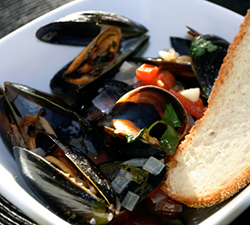Safe Handling and Storing of Fruits and Vegetables

You can reduce your risk of food-borne illness by following these safety tips when buying, storing, handling, and preparing fresh fruits and vegetables:
Buying Fresh Fruits and Vegetables
• Examine the produce carefully and avoid buying items that are bruised or damaged.
• If buying pre-cut or ready-to-eat fruits and vegetables (e.g., cut melons, cut tomatoes, pre-washed salad), be sure they have been properly refrigerated (i.e., at 4°C or below). This means they should be displayed in a refrigerated container and should not just be sitting on top of ice.
• In your grocery cart or hamper, keep fresh fruits and vegetables separated from other raw foods, such as meat, poultry, seafood and their juices. Make sure fruits and vegetables are also kept separate from these other raw foods when they are packed to take home.
Storing Fresh Fruits and Vegetables
• When you get home, promptly refrigerate the fresh fruits and vegetables that need refrigeration. This includes all pre-cut and ready-to-eat produce. Ask your grocer if you are not certain whether specific items need to be refrigerated.
• When you refrigerate fruits and vegetables, keep them separate from meat, poultry, seafood, and their juices to avoid cross-contamination.
• Keep your refrigerator at the proper temperature (4°C or below). Use a fridge thermometer to check.
Handling and Preparing Fresh Fruits and Vegetables
• Always start by washing your hands for at least 20 seconds using hot water and soap.
• Make sure your utensils, cutting boards, and counter-tops have also been cleaned with hot soapy water. When cleaning, avoid using sponges or other materials that are difficult to keep clean and dry, as these can spread bacteria around.
• Before eating or preparing fresh fruits and vegetables:
o Cut away any bruised or damaged areas, since harmful bacteria can thrive in these areas. Be sure to clean your knife with hot water and soap before using it again.
o Wash fruits and vegetables thoroughly under fresh, cool, running water, even if you plan to peel them. This helps prevent the spread of any bacteria that may be present. (This is a general safety tip that may not always apply. For example, you do not need to wash a banana before peeling it.
o Use a clean produce brush to scrub items that have firm surfaces (e.g., oranges, melons, potatoes, carrots, etc.). It is not necessary to use produce cleansers to wash fresh fruits and vegetables.
o Ready-to-eat, bagged, pre-washed leafy greens do not need to be washed again before eating. However, pre-cut or pre-washed leafy greens sold in open bags or containers should be washed before eating.
o Place peeled or cut fruits and vegetables on/into a separate clean plate or container to prevent them from becoming cross-contaminated.
• Refrigerate fresh fruits and vegetables within two hours of peeling or cutting them. Discard any cut fruits and vegetables that have been left at room temperature for more than two hours.
It is also important to pay attention to food recalls and remove affected food items from your home.
Thanks to the Government of Canada website for this information.
Safe Handling of Produce
Fresh produce is an essential part of a healthy diet because it is an important source of vitamins, minerals, fibres, and antioxidants. Because most fruits and vegetables are grown in a natural environment, they can be exposed to a wide range of microorganisms such as bacteria and viruses. Most of these microorganisms do not represent a human health risk, but can cause spoilage. Since produce is usually eaten raw and there are a limited number of practices to effectively control or eliminate pathogens prior to consumption, fruits and vegetables can be a potential source of foodborne illnesses.
Melons:
 Storing Melons
Storing Melons
While melons are best eaten fresh, whole or uncut melons can be stored in the refrigerator and can last 5-15 days in the refrigerator after purchase, depending on the ripeness, variety and growing conditions.
All cut melons should be refrigerated immediately, and can be stored in the refrigerator for up to 4 days at 4ºC (40ºF) or less. Do not leave cut melons at room temperature for longer than two hours; if you do, you should throw them out.
Cleaning and Preparing Melons
• Throw away a melon that is bruised or rotten.
• Before and after handling melons, wash your hands thoroughly with warm water and soap.
• Before cutting the melon, thoroughly wash and scrub the whole melon with warm water using a clean produce brush. This step will help remove bacteria attached to soil. Otherwise, bacteria from the outer rind can transfer to the inner flesh of the melon when cut.
• Thoroughly wash all food equipment and utensils (e.g., counter tops, cutting boards, knives, etc.) that come into contact with the melon, with warm water and soap.
There is no need to use anything other than water when washing melons. Produce washes may not completely remove or kill bacteria, viruses and parasites. Washing melons gently under fresh, running water is at least as effective as using cleansers.
Leafy Greens:
How do I select leafy greens at the grocery store?
When purchasing leafy greens, look for leaves that are crisp and not wilted or brown.
 Storing leafy greens
Storing leafy greens
You should always store leafy greens in the refrigerator at 4ºC (40ºF) or less, where they can be kept for 5 to 7 days. Throw them away if their leaves become wilted or brown. Bagged, ready-to-eat, pre-washed leafy greens should also be refrigerated and used before the expiry date.
Cleaning and preparing leafy greens
Wash your leafy greens under fresh, cool running water. Remove outer leaves and make sure all the dirt is gone. Don’t soak leafy greens in a sink full of water because the sink can harbour bacteria that can be transferred to the leafy greens.
Ready-to-eat, bagged, pre-washed leafy greens do not need to be washed again before eating. However, pre-cut or pre-washed leafy greens sold in open bags or containers should be washed before eating.
There is no need to use anything other than water when washing leafy greens. Produce washes may not completely remove or kill bacteria, viruses and parasites. Washing leafy greens gently under fresh, cool running water is at least as effective as using cleansers.
 Tomatoes
Tomatoes
How do I select tomatoes at the grocery store?
When you buy tomatoes, you should look for any signs of bruising or cuts on the skin, and flesh of the tomato. Because they continue to ripen once they are picked, you should always purchase tomatoes that are firm but not hard.
Storing tomatoes
Store whole tomatoes unwashed and uncovered at room temperature. Make sure that they are stored out of direct sunlight. When the tomatoes are ripe, they should be stored in the refrigerator and should be used within a few days.
Cut tomatoes should always be refrigerated at 4ºC (40ºF) or less and can be kept for up to three days. If the cut or peeled tomatoes have been left out at room temperature for more than two hours, you should throw them away.
Since tomatoes can become contaminated by coming into contact with raw meat, poultry or seafood, be sure to separate raw foods from ready-to-eat foods in the shopping cart at the grocery store, and in the kitchen and refrigerator at home.
Cleaning and preparing tomatoes
You should always wash your hands before handling any fresh produce. Wash your tomatoes under fresh, running water. Make sure you throw out any tomatoes that are bruised or spoiled. Don’t soak tomatoes in a sink full of water because the sink can harbour bacteria that can be transferred to the tomatoes.
There is no need to use anything other than water when washing tomatoes. Produce washes may not completely remove or kill bacteria, viruses and parasites. Washing tomatoes gently under fresh, cool running water is at least as effective as using cleansers.
When you are finished washing your tomatoes, cut out the scar where the stem was, and throw it away.
 Fresh Herbs
Fresh Herbs
How do I select fresh herbs at the grocery store?
Whether you buy fresh herbs from the grocery store or pick them from your garden, make sure the herbs have bright leaves and a fresh smell. The stalks should be crisp and the leaves should not be dried out. If the leaves are beginning to yellow or brown or have black spots, it could mean that the herbs are no longer fresh.
Storing fresh herbs
Fresh herbs can be stored in the refrigerator at 4ºC (40ºF) or less after they have been cut. You should trim the ends of the stalks and place the unwashed fresh herbs into a resealable plastic bag. Store the fresh herbs in the crisper or vegetable bin of your refrigerator and they can be kept refrigerated for up to five days. Fresh herbs can also be kept frozen in a freezer bag after being washed and pat dried with paper towels.
Basil should also be stored unwashed but unlike other fresh herbs, basil should be stored unrefrigerated and uncovered. It is the only herb that should be stored this way because the cold will cause the basil leaves to turn black.
Cleaning and preparing fresh herbs
Wash your fresh herbs under fresh, cool, running water to clean off any dirt. Make sure you throw out any leaves that are yellowing or have spots. Don’t soak fresh herbs in a sink full of water because the sink can harbour bacteria that can be transferred to the fresh herbs.
There is no need to use anything other than water when washing fresh herbs. Produce washes may not completely remove or kill bacteria, viruses and parasites. Washing fresh herbs gently under fresh, cool running water is at least as effective as using cleansers.
 Mushrooms
Mushrooms
How do I select mushrooms at the grocery store?
You should choose fresh mushrooms with no signs of spoilage and bruising.
With fresh, loose mushrooms, choose the ones that are firm and the same color. Prepackaged, fresh mushrooms should be in plastic wrapping or film that has holes in it to allow air flow through the container to prevent the growth of botulism.
Storing Mushrooms
Mushrooms should be eaten fresh and as soon as possible after you buy them. Loose mushrooms should be kept in a paper bag in the refrigerator. Keep your packaged mushrooms in the refrigerator in their original packaging until you open the container. They can be kept in the refrigerator at 4ºC (40ºF) or less for up to five days in a paper bag or in the original packaging to maintain their quality.
Fresh mushrooms should not be frozen. If you would like to freeze mushrooms, they should be steamed or sautéed in a frying pan first. Cooked mushrooms can be kept in the freezer for eight to twelve months.
Cleaning and Preparing Mushrooms
Mushrooms can be cleaned gently with a damp cloth or a soft bristle mushroom brush. You can also rinse them under fresh, running water and pat dry with paper towel. Pay special attention to the underside of the mushroom, because the flesh under the mushroom cap can easily store bacteria and viruses. For quality reasons, do not wash mushrooms until you are ready to use them.
There is no need to use anything other than water when washing mushrooms. Produce washes may not completely remove or kill bacteria, viruses and parasites. Washing mushrooms gently under fresh, running water is at least as effective as using cleansers.
Thanks to the Government of Canada’s website for this information.





























